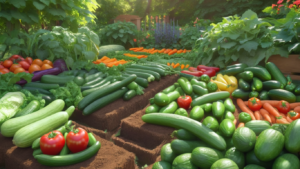Click here to get your very own starter seed kit.
- Introduction
- Importance of companion planting
- Understanding companion planting
- Definition
- Benefits
- Factors to consider when planning companion planting
- Soil compatibility
- Growth habits
- Pest control
- Vegetables that grow well together
- Tomatoes and basil
- Carrots and onions
- Beans and corn
- Lettuce and radishes
- Cucumbers and peas
- Companion planting techniques
- Interplanting
- Succession planting
- Trap cropping
- Avoiding incompatible combinations
- Competition for resources
- Allelopathy
- Conclusion
- Maximizing vegetable garden productivity through companion planting

What Vegetables Grow Well Together
Introduction
When it comes to gardening, success often hinges on more than just choosing the right plants; it’s also about selecting the right companions for them. Companion planting, the practice of growing certain plants together to benefit one another, has been utilized for centuries by gardeners worldwide. In this article, we’ll delve into the concept of companion planting and explore which vegetables thrive when planted together.
Understanding Companion Planting
Companion planting involves strategically pairing plants based on their ability to support each other’s growth. This practice isn’t just about maximizing space or aesthetics; it’s rooted in the biological interactions between different plant species. By harnessing these interactions, gardeners can enhance soil fertility, deter pests, and promote overall plant health.
Factors to Consider When Planning Companion Planting
Soil Compatibility
One crucial factor to consider is soil compatibility. Certain plants have specific soil requirements, so it’s essential to pair those with similar needs. For instance, carrots and onions both prefer well-drained, sandy soil, making them ideal companions in the garden.
Growth Habits
Understanding the growth habits of different vegetables is key to successful companion planting. Plants with similar growth patterns can be interplanted to maximize space and sunlight utilization. For example, tall, vining crops like tomatoes can provide shade and support for smaller plants such as basil.
Pest Control
Companion planting can also help control pests naturally. Some plants emit compounds that repel harmful insects or attract beneficial ones. By strategically interplanting crops, gardeners can create a diverse ecosystem that naturally regulates pest populations.
Vegetables That Grow Well Together
Tomatoes and Basil
Tomatoes and basil are a classic example of companion planting. Basil’s strong aroma can deter pests that commonly afflict tomatoes, such as aphids and whiteflies. Additionally, basil can enhance the flavor of tomatoes when grown nearby.
Carrots and Onions
Carrots and onions make excellent companions in the garden. Onions can help repel carrot flies, while carrots can deter onion flies, reducing the risk of pest infestations for both crops.
Beans and Corn
Beans and corn have a mutually beneficial relationship known as the “three sisters” planting method. Corn provides a sturdy structure for beans to climb, while beans fix nitrogen in the soil, benefiting both crops. Additionally, squash can be planted alongside them to suppress weeds and conserve moisture.
Lettuce and Radishes
Lettuce and radishes are compatible companions that can be grown together in the same bed. Radishes mature quickly and can be harvested before they compete with lettuce for space, allowing for efficient space utilization and crop rotation.
Cucumbers and Peas
Cucumbers and peas thrive when planted together. Peas are nitrogen-fixing legumes that enrich the soil, while cucumbers provide a trellis for peas to climb. This symbiotic relationship benefits both crops and maximizes garden productivity.
Companion Planting Techniques
Interplanting
Interplanting involves mixing different types of plants within the same garden bed. This technique maximizes space utilization and promotes biodiversity, reducing the risk of pest and disease outbreaks.
Succession Planting
Succession planting involves planting multiple crops in the same space throughout the growing season. By staggering planting dates, gardeners can ensure a continuous harvest and optimize resource use.
Trap Cropping
Trap cropping involves planting sacrificial crops to lure pests away from main crops. This technique can help protect valuable vegetables by diverting pests to less desirable plants.
Avoiding Incompatible Combinations
While companion planting offers numerous benefits, it’s essential to avoid incompatible combinations that can hinder plant growth or attract pests.
Competition for Resources
Plants that compete for the same resources, such as sunlight, water, and nutrients, should not be planted together. Instead, select companions that have complementary needs to maximize overall productivity.
Allelopathy
Some plants release chemicals that inhibit the growth of nearby plants, a phenomenon known as allelopathy. Be mindful of which plants may exhibit allelopathic effects and avoid planting them in close proximity to sensitive crops.
Conclusion
Companion planting is a time-tested gardening technique that offers a range of benefits, from improved soil fertility to natural pest control. By understanding which vegetables grow well together and implementing companion planting techniques, gardeners can create thriving, productive gardens that yield bountiful harvests.
FAQs
- Can I plant any vegetables together in my garden?
- While many vegetables have compatible companions, it’s essential to research each plant’s specific needs and interactions before planting.
- How can companion planting help control pests in my garden?
- Companion planting can attract beneficial insects that prey on pests or repel harmful insects through the release of aromatic compounds.
- What is the “three sisters” planting method?
- The “three sisters” planting method involves growing corn, beans, and squash together in the same garden bed, benefiting each crop in various ways.
- Are there any vegetables that should not be planted together?
- Yes, some vegetables may compete for resources or exhibit allelopathic effects, so it’s essential to avoid incompatible combinations.
- How can I incorporate companion planting into my garden design?
- Start by selecting compatible companion plants based on their growth habits, soil compatibility, and pest resistance, then implement interplanting and succession planting techniques to maximize garden productivity.